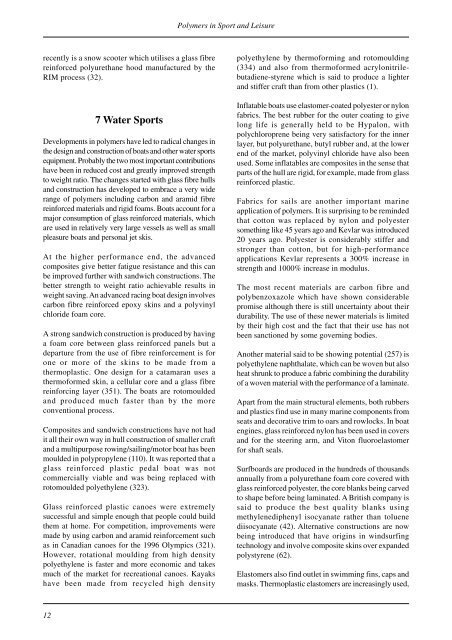Polymers in Sport and Leisure
Polymers in Sport and Leisure
Polymers in Sport and Leisure
Create successful ePaper yourself
Turn your PDF publications into a flip-book with our unique Google optimized e-Paper software.
<strong>Polymers</strong> <strong>in</strong> <strong>Sport</strong> <strong>and</strong> <strong>Leisure</strong><br />
recently is a snow scooter which utilises a glass fibre<br />
re<strong>in</strong>forced polyurethane hood manufactured by the<br />
RIM process (32).<br />
7 Water <strong>Sport</strong>s<br />
Developments <strong>in</strong> polymers have led to radical changes <strong>in</strong><br />
the design <strong>and</strong> construction of boats <strong>and</strong> other water sports<br />
equipment. Probably the two most important contributions<br />
have been <strong>in</strong> reduced cost <strong>and</strong> greatly improved strength<br />
to weight ratio. The changes started with glass fibre hulls<br />
<strong>and</strong> construction has developed to embrace a very wide<br />
range of polymers <strong>in</strong>clud<strong>in</strong>g carbon <strong>and</strong> aramid fibre<br />
re<strong>in</strong>forced materials <strong>and</strong> rigid foams. Boats account for a<br />
major consumption of glass re<strong>in</strong>forced materials, which<br />
are used <strong>in</strong> relatively very large vessels as well as small<br />
pleasure boats <strong>and</strong> personal jet skis.<br />
At the higher performance end, the advanced<br />
composites give better fatigue resistance <strong>and</strong> this can<br />
be improved further with s<strong>and</strong>wich constructions. The<br />
better strength to weight ratio achievable results <strong>in</strong><br />
weight sav<strong>in</strong>g. An advanced rac<strong>in</strong>g boat design <strong>in</strong>volves<br />
carbon fibre re<strong>in</strong>forced epoxy sk<strong>in</strong>s <strong>and</strong> a polyv<strong>in</strong>yl<br />
chloride foam core.<br />
A strong s<strong>and</strong>wich construction is produced by hav<strong>in</strong>g<br />
a foam core between glass re<strong>in</strong>forced panels but a<br />
departure from the use of fibre re<strong>in</strong>forcement is for<br />
one or more of the sk<strong>in</strong>s to be made from a<br />
thermoplastic. One design for a catamaran uses a<br />
thermoformed sk<strong>in</strong>, a cellular core <strong>and</strong> a glass fibre<br />
re<strong>in</strong>forc<strong>in</strong>g layer (351). The boats are rotomoulded<br />
<strong>and</strong> produced much faster than by the more<br />
conventional process.<br />
Composites <strong>and</strong> s<strong>and</strong>wich constructions have not had<br />
it all their own way <strong>in</strong> hull construction of smaller craft<br />
<strong>and</strong> a multipurpose row<strong>in</strong>g/sail<strong>in</strong>g/motor boat has been<br />
moulded <strong>in</strong> polypropylene (110). It was reported that a<br />
glass re<strong>in</strong>forced plastic pedal boat was not<br />
commercially viable <strong>and</strong> was be<strong>in</strong>g replaced with<br />
rotomoulded polyethylene (323).<br />
Glass re<strong>in</strong>forced plastic canoes were extremely<br />
successful <strong>and</strong> simple enough that people could build<br />
them at home. For competition, improvements were<br />
made by us<strong>in</strong>g carbon <strong>and</strong> aramid re<strong>in</strong>forcement such<br />
as <strong>in</strong> Canadian canoes for the 1996 Olympics (321).<br />
However, rotational mould<strong>in</strong>g from high density<br />
polyethylene is faster <strong>and</strong> more economic <strong>and</strong> takes<br />
much of the market for recreational canoes. Kayaks<br />
have been made from recycled high density<br />
polyethylene by thermoform<strong>in</strong>g <strong>and</strong> rotomould<strong>in</strong>g<br />
(334) <strong>and</strong> also from thermoformed acrylonitrilebutadiene-styrene<br />
which is said to produce a lighter<br />
<strong>and</strong> stiffer craft than from other plastics (1).<br />
Inflatable boats use elastomer-coated polyester or nylon<br />
fabrics. The best rubber for the outer coat<strong>in</strong>g to give<br />
long life is generally held to be Hypalon, with<br />
polychloroprene be<strong>in</strong>g very satisfactory for the <strong>in</strong>ner<br />
layer, but polyurethane, butyl rubber <strong>and</strong>, at the lower<br />
end of the market, polyv<strong>in</strong>yl chloride have also been<br />
used. Some <strong>in</strong>flatables are composites <strong>in</strong> the sense that<br />
parts of the hull are rigid, for example, made from glass<br />
re<strong>in</strong>forced plastic.<br />
Fabrics for sails are another important mar<strong>in</strong>e<br />
application of polymers. It is surpris<strong>in</strong>g to be rem<strong>in</strong>ded<br />
that cotton was replaced by nylon <strong>and</strong> polyester<br />
someth<strong>in</strong>g like 45 years ago <strong>and</strong> Kevlar was <strong>in</strong>troduced<br />
20 years ago. Polyester is considerably stiffer <strong>and</strong><br />
stronger than cotton, but for high-performance<br />
applications Kevlar represents a 300% <strong>in</strong>crease <strong>in</strong><br />
strength <strong>and</strong> 1000% <strong>in</strong>crease <strong>in</strong> modulus.<br />
The most recent materials are carbon fibre <strong>and</strong><br />
polybenzoxazole which have shown considerable<br />
promise although there is still uncerta<strong>in</strong>ty about their<br />
durability. The use of these newer materials is limited<br />
by their high cost <strong>and</strong> the fact that their use has not<br />
been sanctioned by some govern<strong>in</strong>g bodies.<br />
Another material said to be show<strong>in</strong>g potential (257) is<br />
polyethylene naphthalate, which can be woven but also<br />
heat shrunk to produce a fabric comb<strong>in</strong><strong>in</strong>g the durability<br />
of a woven material with the performance of a lam<strong>in</strong>ate.<br />
Apart from the ma<strong>in</strong> structural elements, both rubbers<br />
<strong>and</strong> plastics f<strong>in</strong>d use <strong>in</strong> many mar<strong>in</strong>e components from<br />
seats <strong>and</strong> decorative trim to oars <strong>and</strong> rowlocks. In boat<br />
eng<strong>in</strong>es, glass re<strong>in</strong>forced nylon has been used <strong>in</strong> covers<br />
<strong>and</strong> for the steer<strong>in</strong>g arm, <strong>and</strong> Viton fluoroelastomer<br />
for shaft seals.<br />
Surfboards are produced <strong>in</strong> the hundreds of thous<strong>and</strong>s<br />
annually from a polyurethane foam core covered with<br />
glass re<strong>in</strong>forced polyester, the core blanks be<strong>in</strong>g carved<br />
to shape before be<strong>in</strong>g lam<strong>in</strong>ated. A British company is<br />
said to produce the best quality blanks us<strong>in</strong>g<br />
methylenediphenyl isocyanate rather than toluene<br />
diisocyanate (42). Alternative constructions are now<br />
be<strong>in</strong>g <strong>in</strong>troduced that have orig<strong>in</strong>s <strong>in</strong> w<strong>in</strong>dsurf<strong>in</strong>g<br />
technology <strong>and</strong> <strong>in</strong>volve composite sk<strong>in</strong>s over exp<strong>and</strong>ed<br />
polystyrene (62).<br />
Elastomers also f<strong>in</strong>d outlet <strong>in</strong> swimm<strong>in</strong>g f<strong>in</strong>s, caps <strong>and</strong><br />
masks. Thermoplastic elastomers are <strong>in</strong>creas<strong>in</strong>gly used,<br />
12










